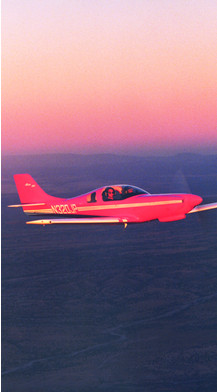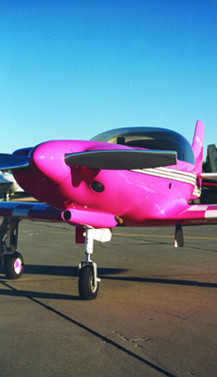|
SW Aviator Magazine
|
3909 Central NE
Albuquerque, NM 87108
Phone: 505.256.7031
Fax: 505.256.3172 |
| editor@swaviator.com |
|
| Lancair 320 |
| by Kevin McKown |
When Lance Neibauer introduced his all-composites two-seat kit airplane at Oshkosh in 1985, the general aviation world greeted him with open arms. Pilots worldwide were ready for a new design. His first kitplane design was the Lancair 200. Sleek, fast and beautiful, the Lancair 200 established the basic parameters for the designs that were to follow.
By the time Lancair moved from California to the Redmond airport in 1991, kit deliveries of the retractable gear, four-seat model Lancair IV had begun, and customer-built Lancair 320s and 360s were picking up awards at air shows across the country. Soon after the move, a pressurization system was developed for the Lancair IV, making it one of the most advanced kitplanes in the world. After the pressurization, Lance went to work designing a fixed-gear, four-seat kitplane that would have more docile handling characteristics than the Lancair IV. This model was the Lancair ES.
In July 1999, another model was introduced, the Legacy 2000. This model is the successor to the Lancair 320/360. The Legacy 2000 provides additional space through increased width and cabin height. The superbly balanced control system and tight responsiveness provides for not only an exciting aircraft but an excellent cross-country machine.
Lance has continued to expand in the general aviation world and is now entering the certified market. Pacific Aviation Composites, based at the Bend airport, Oregon, offers a factory-built, fixed gear, four-seat 220 mph cruiser called the Columbia 300. The first customer airplane is now flying and performing FAA acceptance flights.
|
 |
 |
Richard Guston of Albuquerque, NM is the present owner of N320JP. Richard told us he isn’t responsible for the color choice–that decision was made by the builder, John Poco of Livermore, CA. Richard explained that John built the Lancair in 1992, and the reason behind the paint job was that John enjoyed rolling the dice at Circus Circus in Reno, NV. Hence, the checkerboard pattern on the wings (to represent dice rolling.)
Richard had some reservations about buying a pink airplane but when paying attention to the detail and craftsmanship taken in the building of N320JP, his mind was made up–pink or not. The little Lancair is quite complete in the avionics department with a twelve function (Vision) engine monitoring system and a King 89-GPS with moving map backed by an S-Tech 50 two axis autopilot that is coupled!
N320JP weighs in empty at 1130 pounds, some 80 pounds heavier than Lancair’s suggested builder specifications. The 320 carries 43 gallons in a wet wing. Richard claims a 7.5 gallon per hour burn, allowing a flight of approximately 5 hours–at over 200 mph.
|
Our flight day was typical Southwest: not a cloud to be seen, the wind was dead calm and the temperature was 57&Mac251;F. As we went through the checklist and runup there was a question of go or no go: JP was running a little rough that day. But a little fiddling with the mixture during warmup and the decision was GO!
The tower cleared us and down the runway we went. Climb was at 500' per minute and 140 mph–not extremely impressive. But, as soon as we leveled out we seemed to rocket well above 230 mph in a matter of seconds–that was impressive.
The controls were very light to the touch, and the snappy response of the 320 was surprising. One of the most noticeable aspects was the quick acceleration and deceleration. The size and agility of the plane allowed us to fly circles around the Bonanza that accompanied us on our flight.
Approach speed was about 90 mph, and we touched down at about 65 mph, carrying power throughout the landing. The response of the 320, while favorable in flight, can lead to trouble on landing. The short control stick requires only slight movement, and overcorrection can be quite eventful.
|
 |
MODEL 320 FACTORY SPECS
|
| Engine |
LYC IO-320 DIB
|
| Horsepower |
160
|
| Prop |
2-Blade Constant Speed
|
| Length |
21 feet
|
| Wingspan |
23.5 feet
|
| Wing Area |
76 square feet
|
| Wing Loading |
19 lb/square foot
|
| Power/Loading |
9.36 lb /pr hp
|
| Aspect Ratio |
7.1:1
|
| G-Loading (ULT) |
9+/4.5-
|
| Empty Weight |
1050 lb
|
| Gross Weight (Max) |
1685
|
| Fuel Capacity |
43 Std/53 opt
|
| Useful Load |
645 lb
|
| Baggage capacity |
50-70 lb/max
|
| Cabin Width |
42.4 inches
|
| Cabin Height |
42.5 inches
|
| Max Speed SL |
250 mph
|
| Cruise Typical |
225 mph
|
| Stall (dirty) |
63 mph
|
| Service Ceiling |
18,000 feet
|
| TO-distance |
390
|
| LN-distance |
900
|
| Crosswind Comp |
21 mph
|
| Fuel Consumption @ 75% |
9 GPH
|
| Max Range (no reserve) |
1020/1250 SM
|
| Rate of Climb (at gross) |
1950 FPM
|
|
|
|
| Click here to return to the beginning of this article. |
|
The material in this publication is for advisory information only and should not be relied upon for navigation, maintenance or flight techniques. SW Regional Publications and the staff neither assume any responsibilty for the accuracy of this publication's content nor any liability arising out of it. Fly safe.
|
|
|


